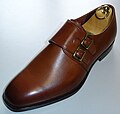A double monk shoe
Illustration of a man's single-strap monk dress shoe
A monk shoe or monk strap is a style of dress shoe with no lacing, instead secured on the feet by one or multiple buckles and straps. [1] [2] It was innovated by the English shoe maker Edward Green in the late 19th century. [3]
Contents
The monk shoe is a moderately formal shoe: less formal than a full Oxford (American: Balmoral); but more so than an open Derby (American: Blücher). [4] [5] In between these, it is one of the main categories of men's shoes.
The monk shoe is described by some specialists in the fashion sector as the most accomplished men's dress shoe. [6] [7] It often has a cap toe, is occasionally brogued, and is popular in suede.
Differences between the Monk, the Derby and the Oxford shoe




